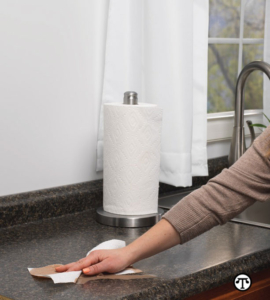FOR YOUR HEALTH – Kitchen Contamination: How To Keep Your Family Safe
 (NAPSI)—The next time you need to wipe up a spill, health expert Dr. Charles Gerba, Professor of Environmental Microbiology, University of Arizona, aka “Dr. Germ,” warns: don’t always reach for a sponge or dishcloth.
(NAPSI)—The next time you need to wipe up a spill, health expert Dr. Charles Gerba, Professor of Environmental Microbiology, University of Arizona, aka “Dr. Germ,” warns: don’t always reach for a sponge or dishcloth.
Instead, use a paper towel. That’s because kitchen sponges, which he calls “bacteria cafeterias,” are the No. 1 source of germs in the house. The average sponge carries nearly 5.5 trillion microscopic bugs.
When to Reach for a Paper Towel
 According to a recent study on cleaning habits, the majority of millennials reach for sponges or cloth dishtowels when cleaning surfaces that have raw meat or poultry. Dr. Gerba recommends using paper towels, especially when prepping and cleaning up raw meat and eggs. Sponges and dishtowels can instantly become contaminated after handling these foods, which may contain bacteria such as E. coli and salmonella, Dr. Gerba explains.
According to a recent study on cleaning habits, the majority of millennials reach for sponges or cloth dishtowels when cleaning surfaces that have raw meat or poultry. Dr. Gerba recommends using paper towels, especially when prepping and cleaning up raw meat and eggs. Sponges and dishtowels can instantly become contaminated after handling these foods, which may contain bacteria such as E. coli and salmonella, Dr. Gerba explains.- Paper towels should also be used to help contain spills and prevent them (and subsequent germs) from spreading around the kitchen. Whether soaking up bacon grease or cleaning up oil splatters, paper towels pick up spills quickly and efficiently. For larger oil spills, cover with baking soda or salt for about 15 minutes, then pick it up with a paper towel and throw it out.
- When cleaning the refrigerator, dampen a paper towel with warm water and dish washing liquid and wipe down all trays, drawers, shelves and walls at least once a week. Using a sponge increases the risk of bacteria spreading around the various surfaces and shelves.
- When kids are in the kitchen, use paper towels to clean-up everything from spills on high chair tables to sippy cups and bibs. “This ensures germ-ridden messes get tossed right into the trash and don’t linger on kids’ items,” adds Dr. Gerba.
When People Actually Reach for a Paper Towel
While there’s been an increasing amount of studies and data showcasing the high bacterial risks associated with kitchen sponges and cloth dishtowels, a recent study on cleaning habits showed that a over half of millennials (59 percent) and nearly half of baby boomers (49 percent) reach for a sponge or cloth dishtowel when cleaning kitchen counter tops.
Even more surprising, less than half of millennials think they run a risk of possible illness or food poisoning by not cleaning these kitchen durables.
The truth is, sponges and cloth dishtowels become germ-infested as soon as they’re first used in the kitchen.
As for baby boomers, most clean their cloth dishtowels once a week, which is still not as frequent as it should be (ideally, everyday). Also, how to clean is just as important as when to clean.
“Cold water washes are awful for eliminating bacteria from fabrics,” says Dr. Gerba. “Washing sponges in warm water does not get rid of the bacteria unless you add bleach,” he adds.
So when it comes to helping keep your kitchen clean and germ-free, let a paper towel be your shield.





 Smart and Delicious Choices
Smart and Delicious Choices
 Catching lice early is vital in halting the spread of these itchy pests. It can take four to six weeks after infestation begins for itching to start, and not everyone develops this telltale symptom. Help the entire family to avoid an outbreak by acting quickly after exposure.
Catching lice early is vital in halting the spread of these itchy pests. It can take four to six weeks after infestation begins for itching to start, and not everyone develops this telltale symptom. Help the entire family to avoid an outbreak by acting quickly after exposure.